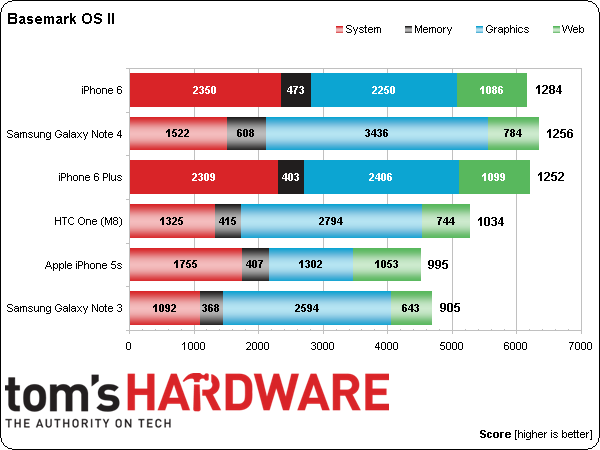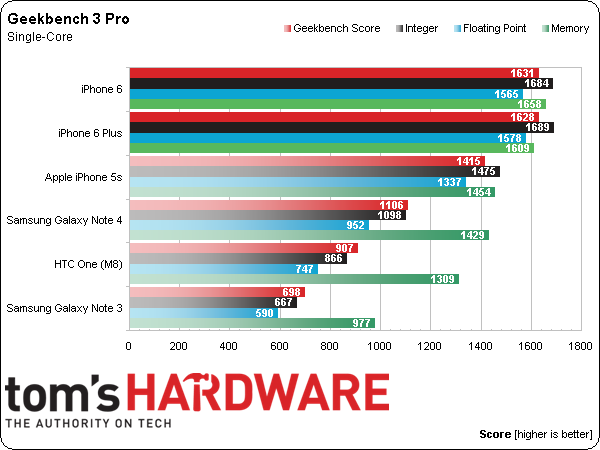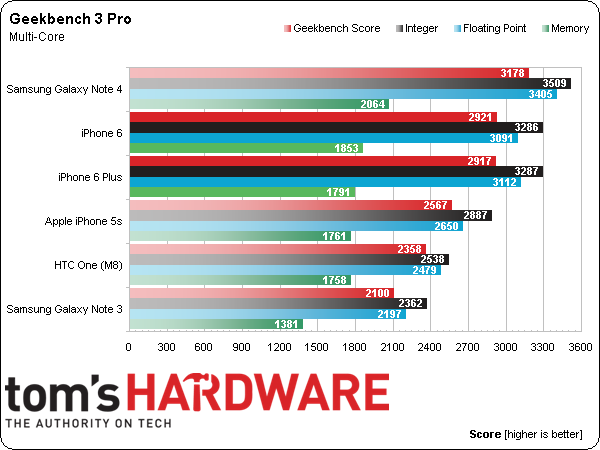Apple iPhone 6 And iPhone 6 Plus Review
The iPhone 6 and 6 Plus are bigger and better than ever, but are they a worthy upgrade for existing iPhone users? What if you previously passed over the iPhone because of its small screen, does it now merit a second look?
Why you can trust Tom's Hardware
Test Results: CPU Core Benchmarks
Basemark OS II Full (Anti-Detection)
Basemark OS II is an all-in-one tool designed for measuring overall performance of mobile devices. It scores each device in four main categories: System, Memory, Graphics and Web.
The System score reflects CPU and memory performance, specifically testing integer and floating-point math, along with single- and multi-core CPU image processing using a 2048x2048-pixel, 32-bit image.
Measuring the transfer rate of the internal NAND storage (Memory) is done by reading and writing files with a fixed size, files varying from 65KB to 16MB, and files in a fragmented memory scenario.
Calculating the Graphics score involves mixing 2D/3D graphics inside the same scene, applying several pixel shader effects, and displaying 100 particles with a single draw call to test GPU vertex operations. The benchmark is rendered at 1920x1080 off-screen 100 times before being displayed on-screen.
Finally, the Web score stresses the CPU by performing 3D transformations and object resizing with CSS, and also includes an HTML5 Canvas particle physics test.
Apple's Cyclone architecture performs well in CPU-centric benchmarks. A year after its initial launch, it's still faster than the latest Krait and ARM CPUs. Even Nvidia’s Tegra K1 couldn’t beat the A7 in these tests, the lone exception being Geekbench 3 Pro Multi-Core. Now with the A8 SoC, Apple looks to extend its lead even further.
The improved Cyclone cores in the A8 outperform the A7 in the iPhone 5s by 34% in the System test, which is significantly more than the ~8% bump in clock rate can explain. This is likely the summation of several smaller tweaks, like the improvement in sequential memory access, rather than a significant pipeline change.
Get Tom's Hardware's best news and in-depth reviews, straight to your inbox.
The iPhone 6 sees only a modest improvement over the 5s in the Web test, which includes a particle physics simulation similar to 3DMark Ice Storm Unlimited, a test that Cyclone has never handled well. Still, the 6 Plus manages to score 40% higher than the Note 4.
The iPhone 6 Plus performs on par with the 5s and HTC One (M8) in the Memory metric, with the iPhone 6 showing a slight advantage. The iFixit teardown of the iPhone 6 shows it using SanDisk NAND, which, based on this measurement, seems to offer slightly better performance than the SK Hynix NAND found in the 6 Plus. The Note 4 offers the best storage performance of the group.
Looking more closely, however, shows the iPhone 6 averaging around 3x faster in read operations, while the Note 4 is about 2.5x faster in the variable length and fragmented write tests. Boosting the Note 4’s overall Memory score is its fixed size write throughput, which is 6x faster than the iPhone 6.
The PowerVR GX6450 in the A8 gives mixed results in the Graphics test. It's 73% faster than the 5s, topping Apple's claim of 50%-better GPU performance, but is still slower than the Adreno 330 and 43% slower than the newer Adreno 420. We've seen the PowerVR G6430 in the A7 perform better than the Adreno 330 in some benchmarks, so Imagination's latest GPU still has a chance to take the overall win.
Curiously, the 6 Plus outperforms the iPhone 6 in the Graphics test by 7%. This test is run off-screen so both phones should fare similarly. Is this just an anomaly or will we see the trend continue in our other graphics benchmarks?
Geekbench 3 Pro (Anti-Detection)
Primate Labs' Geekbench offers a wide selection of cross-platform compatibility, with apps available for Windows, OS X, Linux, iOS and Android. This simple system benchmark produces two sets of scores: single- and multi-threaded. For each, it runs a series of tests in three categories: Integer, Floating Point, and Memory. The individual results are used to calculate category scores, which, in turn, generate overall Geekbench scores.
Once again we see the improved Cyclone CPU extend its lead over Krait in single-core performance. The iPhone 6 is 54% faster than the Note 4 in the Integer test and 66% faster in Floating Point math.
Compared to the A7 in the iPhone 5s, A8 sees about a 15% average improvement for the Integer performance tests and 18% for the Floating Point tests. As noted earlier, cryptography sees the smallest improvement, while the Lua and Dijkstra tests improve by 30%. The BZip2 and JPEG compression tests, which should rely on sequential memory access, show around a 15% improvement, nearly the same result as the STREAM Copy memory test.
In the multi-core test, we see the Galaxy Note 4 leverage its quad-core Krait 450 CPU to outperform the iPhone 6. Even with half as many cores and almost half the clock rate, Apple's improved Cyclone CPU is within 10% of Krait 450.
The multi-core performance gains for the iPhone 6 relative to the 5s are similar to those in the single-core tests.
Current page: Test Results: CPU Core Benchmarks
Prev Page How We Tested Apple’s iPhone 6 And iPhone 6 Plus Next Page Test Results: HTML5 And JavaScript Benchmarks-
blackmagnum Everyone would want to own one and be the envy of their peers. They want a device that is attractive, well-made and intuitive. That's how Apple sells them by the millions, don't you agree?Reply -
lanbaner Nvidia has a better GPU. The G3 has a better display. The Note 4 has better camera. Gone are the days were the iPhone was the leader on all fronts. Would be nice to see all the strengths from the competition in one phone. Considering the transition to 20nm for Maxwell early next year we could possibly see an iPhonekiller on all aspects. Although I have to agree that the build quality on the iPhones is always top notch.Reply -
M3God Other then just sticking to just 1GB internal memory, there is no mention that apple switched to cheaper and slower TLC memory to make more profits while screwing the customer. The TLC memory has been linked to crashes and bootloops that require a trip to the apple store.Reply -
aaaas I browse the Web and talk on the phone on Verizon all the time. At least the last two generations of devices have been able to do this... at least for android...Reply
Interesting article, as I've been considering a switch to iphone. -
KaptainK " Wi-Fi calling is currently only supported by T-Mobile in the U.S."Reply
Not True! Republic Wireless has been using wi-fi calling for years. Republic also includes a feature where it will hand the call off from wi-fi to cellular if you leave the wi-fi zone during the call. Does the iPhone do this?? -
cknobman A. Thanks for including the Lumia 1520 in the comparison chart of phablets, most other sites dont do this.Reply
B. The price for the 6 plus in that same chart ($299) is on contract while every other device price is off contract.
As a whole if you are an iPhone user I am sure you are happy with the changes made to the 6. Outside of that the iPhone "cool factor" ship has sailed and this wont be winning over many Android users. -
cmi86 How can this guy sit here and hump apples leg by saying the A8 should be competitive if not class leading when it's competition averages over 1Ghz higher clock speed and 2 more cores.... I know a lot of people doing reviews now a days feel obligated to shine up certain companies and make their products appear in a positive light. This is not that... this is a blatant lie.Reply -
SirKnobsworth How can this guy sit here and hump apples leg by saying the A8 should be competitive if not class leading when it's competition averages over 1Ghz higher clock speed and 2 more cores.... I know a lot of people doing reviews now a days feel obligated to shine up certain companies and make their products appear in a positive light. This is not that... this is a blatant lie.Reply
Clock speeds and core counts can be deceptive, the key point here being that Apple's Cyclone cores can execute about twice as many instructions per clock cycle as most of their competitors. This shows up in the benchmarks - the iPhone 6 and 6+ do very well in single threaded tests, though tend to lag behind competitors in multithreaded tests like physics. Note that this is also the approach that Nvidia is taking with their Denver cores - fewer, bigger cores as opposed to more small cores.
How this translates into actual performance will vary of course - most smartphone workflows aren't particularly well threaded so having four cores as opposed to two probably won't make a huge difference in many situations, but I'm sure there are plenty of exceptions. -
ZXS ReplyDue to their zero reading on the black level tests, AMOLED displays are said to have an infinite contrast ratio.
MATT, do you know this is Samsung's marketing BS?
Smartphone displays reflect about 6% of incoming light (which is much more than LCD backlight emits). Actual contrast of AMOLED is worse than that of LCD since the reflections are so high, but maximum brightness is much lower than that of LCD.


